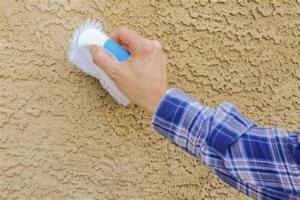Effortless Ways to Clean Stucco: A Comprehensive Guide for Homeowners

-
Quick Links:
- Introduction
- Understanding Stucco
- Importance of Cleaning Stucco
- Tools and Materials Needed
- Step-by-Step Cleaning Guide
- Preventative Maintenance Tips
- Case Studies
- Expert Insights
- FAQs
- Conclusion
Introduction
Stucco is a popular exterior finish for homes, known for its durability and aesthetic appeal. However, like any exterior material, stucco requires regular maintenance and cleaning to ensure it retains its beauty and functionality. In this comprehensive guide, we will explore various methods to clean stucco effectively, the tools you need, and tips for maintaining its appearance over time.
Understanding Stucco
Stucco is a mixture of sand, cement, lime, and water, which is applied in layers over a wire mesh base. It can be textured or smooth, and comes in a variety of colors. Understanding the composition and properties of stucco is essential for effective cleaning and maintenance.
Types of Stucco Finishes
- Traditional Stucco: Made from a mixture of Portland cement, sand, and lime.
- Modern Synthetic Stucco: Known as EIFS (Exterior Insulation and Finish System), this is a lightweight alternative.
- Textured Stucco: Commonly used for its aesthetic appeal, featuring various textures.
Importance of Cleaning Stucco
Regular cleaning of stucco is crucial for several reasons:
- Prevent Mold and Mildew: Moisture can lead to mold growth, which can damage the stucco and pose health risks.
- Enhance Curb Appeal: A clean stucco exterior improves the overall look of your home.
- Increase Longevity: Regular maintenance extends the life of the stucco finish.
Tools and Materials Needed
Before starting the cleaning process, gather the following tools and materials:
- Soft-bristle brush
- Pressure washer (optional)
- Bucket
- Garden hose
- Detergent or specialized stucco cleaner
- Protective eyewear and gloves
Step-by-Step Cleaning Guide
Follow these steps to clean your stucco effectively:
Step 1: Prepare the Area
Remove any furniture or decorative items near the stucco wall. Cover plants and landscaping with tarps to protect them from cleaning solutions.
Step 2: Choose Your Cleaning Method
There are different methods for cleaning stucco:
- Using a Soft-Bristle Brush: Mix detergent with water and apply it using a soft-bristle brush. Gently scrub the area to remove dirt and grime.
- Pressure Washing: For tougher stains, a pressure washer can be effective. Use a wide-angle nozzle to avoid damaging the stucco.
Step 3: Rinse Thoroughly
After scrubbing, rinse the area with clean water. Ensure no soap residue remains, as this can lead to streaking.
Step 4: Inspect for Damage
Check for cracks or damage in the stucco. Address any issues immediately to prevent further deterioration.
Preventative Maintenance Tips
To keep your stucco looking fresh, consider these preventative maintenance tips:
- Inspect the surface regularly for cracks and stains.
- Seal the stucco if it shows signs of wear.
- Maintain proper drainage around the home to prevent water accumulation.
- Trim back vegetation that may hold moisture against the stucco.
Case Studies
Case Study 1: Residential Home in Florida
A homeowner in Florida noticed mold growth on their stucco surface. After following our cleaning guide, they were able to restore the stucco’s appearance and prevent mold from returning by implementing regular maintenance.
Case Study 2: Apartment Complex in California
An apartment complex faced issues with efflorescence on their stucco walls. By using a specialized cleaner and pressure washing method, they successfully cleaned the surfaces and improved the property’s curb appeal.
Expert Insights
We consulted with industry experts to gather insights on best practices for cleaning stucco:
“Always use gentle cleaning methods first before resorting to pressure washing. High pressure can damage stucco surfaces if not used correctly.” - John Smith, Home Improvement Expert
FAQs
1. How often should I clean my stucco?
It is recommended to clean stucco at least once a year to prevent mildew and maintain its appearance.
2. Can I use bleach to clean stucco?
While bleach can be effective for mold, it may discolor the stucco. It’s better to use a solution specifically designed for stucco cleaning.
3. Is pressure washing safe for stucco?
Yes, but use a wide-angle nozzle and keep the pressure low to avoid damage.
4. What should I do if my stucco has cracks?
Inspect the cracks and consider sealing them with a stucco repair kit. If extensive, consult a professional.
5. How do I remove oil stains from stucco?
Use a degreaser or a mixture of water and dish soap to scrub the area, then rinse thoroughly.
6. Can I paint over dirty stucco?
Cleaning is essential before painting. Dirty surfaces can lead to paint peeling off.
7. What is the best time of year to clean stucco?
Spring and fall are ideal times for cleaning stucco as the weather is typically mild.
8. Does stucco need to be sealed?
Sealing stucco can help protect it from moisture and stains, especially in areas with heavy rainfall.
9. Can I use a garden hose instead of a pressure washer?
Yes, a garden hose with a spray nozzle can effectively clean stucco, especially for light dirt and grime.
10. Are there any cleaning products I should avoid?
Avoid harsh chemicals or abrasive cleaners that can damage the stucco surface.
Conclusion
Cleaning stucco may seem daunting, but with the right tools and techniques, it can be a straightforward process. Regular maintenance not only enhances the aesthetic appeal of your home but also prolongs the life of the stucco finish. By following the guidelines outlined in this article, you can ensure that your stucco remains in excellent condition for years to come.